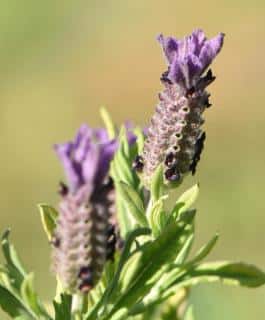

A wonderful species of lavender often grown as an ornamental, Lavandula stoechas offers beautiful blooms and a nice, tight growth habit.
Lavandula stoechas facts
Name – Lavandula stoechas
Common names – French lavender,
Spanish lavender, butterfly lavender
Family – Lamiaceae
Type – herbaceous shrub
Height – 12 to 36 inches (0.3 to 0.9 m)
Exposure – fully exposed to the sun
Soil – ordinary or alkaline, draining well
Foliage – evergreen
Flowering – mid-spring to late summer,
or even all year round (depends on climate & variety)
This species has striking varieties that will embellish every garden. Learn how to plant, water, and care for L. stoechas sub-shrubs.
Drainage and exposure are the two most crucial considerations.
Do your best to increase drainage upon planting:
With these steps, your Lavandula stoechas can be planted almost everywhere, even in heavy clay soil!
Water abundantly once upon planting. If it drains well enough, it shouldn’t form a puddle for more than a couple seconds. Water should drain away before a minute has passed.
After planting, no need to water anymore except during very long droughts, and only the first year.
Lavandula stoechas will grow perfectly in a pot. Terra cotta pots are slightly better than plastic, since they tend to dry out faster.
When the pot is thus prepared, add soil mix, your Lavandula clump, and backfill.
Don’t set the pot in a saucer that collects water, especially if you’re keeping the plant out where it rains. Having water stagnate at the bottom of the pot is a nightmare for all the types of lavender.
In summer, water is only needed when it hasn’t rained for two or three weeks. This is for plant in the ground.
For L. stoechas growing in pots, a good practice is to test if the soil is dry before watering. Also, don’t water more than once a week except if temperatures are extremely high.
Lavandula stoechas is hardy down to 10°F (-10°C), but it only survives when drainage is impeccable.
If winters are very wet and cold, make sure your plant sits high above ground level.
In the ground, there is absolutely no need for fertilizer.
In pots, apply a low dose of regular plant fertilizer (or make your own from weeds such as comfrey or stinging nettle) whenever watering or just after strong rain.
In summer:
Roots will start growing from the nodes where leaves were pinched off.
Perform clump division to break a large clump into smaller ones. These you can transplant.
Seeds are tiny but will germinate readily. You can start growing them in a tray towards the end of winter and plant them to the ground after the last frost in spring.
A hand pruner and long shears will make quick work of the task:
When the bush grows unruly, you can thin it, too:
A rare favorite is the blushing Lavandula stoechas ‘Kew Red’ variety, which has wonderful violet-red flowerheads.
As seen above, the greatest – and only – threat to Lavandula stoechas is root rot. This is usually caused by soil that doesn’t drain well enough. Nonetheless, if you water too often, even the most perfect draining soil won’t keep root rot from striking.
There are rarely any reports of leaf spot diseases or insects, apart from the random caterpillar that has lost its way. No need to fight it away, it will quickly leave of its own accord. Adult butterflies, though, love sipping nectar alongside bees. A large white drinking from a lavender flower is a beautiful sight!

It’s one of the most fragrant lavenders. Oils in it are concentrated even more when drought and hot weather strike. It’s often used in cosmetics and perfumes.
Use Lavandula stoechas in cut-flower bouquets and pot-pourris. The flower grains, when dry, remain more firmly attached to the stem and won’t fall off. This is also an advantage when making lavender wands.
The strong fragrance makes it a bit too powerful for cooking, though, unlike other common lavender varieties.
Softer and hardier, both Lavandula angustifolia and Lavandula dentata are more suited to that purpose.
Lavandula stoechas is perfect for short, thick lavender wands. Stalks are shorter and flowers more compact than other lavender flowers.